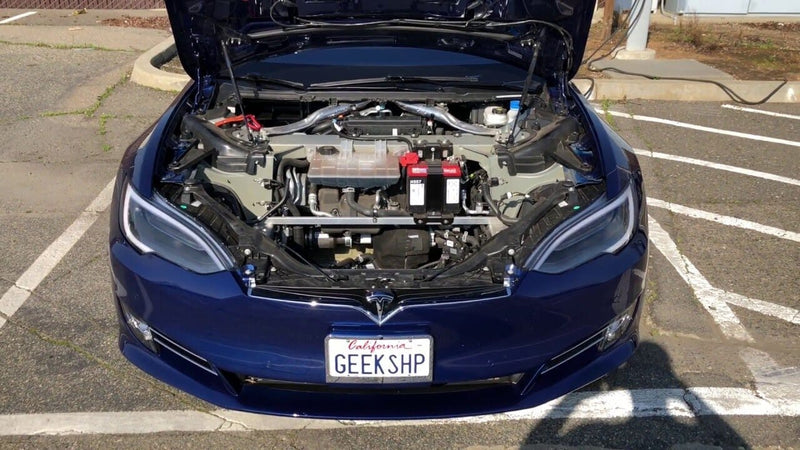What kind of motor does a Tesla have?
Asking these questions? This quick article answers that - I'm Riz Nwosu from Cyberbackpack.com :)
You see, cars have advanced significantly since Tesla's first Model T. Modern automobiles come with all kinds of high-tech capabilities, like hands-free calling and GPS navigation.
Tesla, the innovative electric vehicle company, has garnered a lot of attention in recent years for its cutting-edge technology and environmentally-friendly approach to transportation. But one question that often arises is whether or not Tesla has engines.
The engine, though, is one aspect that hasn't altered much over time.
Although engines have become more powerful and efficient, they continue to function much in the same manner as they always did.
So far, at least. Elon Musk's electric vehicle company Tesla has created a brand-new "engine" that has the potential to completely alter the automobile sector.
Tesla vehicles do not have engines. Electric motors, instead of gasoline engines, power Tesla vehicles. Electric motors produce minimal pollution and are more effective as compared to gasoline engines.
Because of this, buyers who care about the environment are drawn to Tesla's vehicles.
Before we proceed, there are some exceptions to the rule which occur when a Tesla owner takes it upon themselves to put an internal combustion engine in a Tesla.
You can also check out this article that takes a deeper dive into each Tesla model as we attempt to answer the question - do Teslas have engines.
Do Tesla cars have an engine?
The short answer is yes, Tesla does have engines despite the photo above. The engines in Tesla vehicles are not the same type of internal combustion engines that are commonly found in traditional gasoline-powered cars. Instead, Tesla vehicles are powered by electric motors that are fueled by battery packs.
While traditional engines rely on the combustion of fossil fuels to create motion, electric motors use electricity to power the rotation of a magnetic field, which in turn drives the motion of the vehicle. This means that Tesla vehicles do not produce any harmful emissions, making them a more environmentally-friendly option than gas-powered cars.
But how do Tesla's electric engines compare to traditional engines in terms of performance and efficiency?
In terms of performance, electric motors have several advantages over traditional internal combustion engines. For one, electric motors have much higher power density, meaning they can produce more power per unit of weight. This allows Tesla vehicles to have impressive acceleration and speed, even when compared to high-performance sports cars with traditional engines.
In addition, electric motors have a much higher torque output than internal combustion engines. Torque is a measure of the rotational force produced by the engine, and it plays a crucial role in a vehicle's acceleration and ability to climb hills. Electric motors have a much higher torque output at low speeds, which allows Tesla vehicles to have impressive acceleration from a standstill.
In terms of efficiency, electric motors are much more efficient than internal combustion engines. This is because electric motors do not rely on the combustion of fossil fuels, which is an inherently inefficient process. Instead, electric motors convert electricity directly into motion, which is a much more efficient process.
Additionally, electric motors do not suffer from the same issues with mechanical friction that traditional engines do. This allows electric motors to operate at a much higher efficiency, which translates into a longer range and improved fuel economy for Tesla vehicles.
While Tesla's electric engines may not be the same as traditional internal combustion engines, they offer numerous advantages in terms of performance and efficiency. This is one of the reasons why Tesla has become such a popular and successful electric vehicle company.
Model S

A full-size sedan with room for up to five persons and a trunk in the front and another in the back— Model S is Tesla's flagship vehicle. It has a four-wheel drive, can go from zero to 60 mph within 1.9 seconds, and has a range of 375 miles on one charge.
The Model S employs a 3-phase monitor for AC induction and has double electric motors. Both the front and the rear have one.
The wheels are powered by a battery that is attached to each motor. The car's front and rear motors each drive the vehicle's front and rear wheels, respectively.
Tesla's Model S also features a gasoline engine so it can produce electricity for the battery pack of the vehicle.
It can be found under the vehicle's bonnet, between the electric motors.
Model X
Model X is an SUV by Tesla. It features two trunks and can accommodate up to seven people. It has a four-wheel drive, a full charge will allow you to go 329 miles and accelerate to 62 mph within 3.8 seconds.
Along with some rather outstanding safety features, the SUV also has features that prevent side collision avoidance and automatic braking for emergencies.
Additionally, it has all the features you'd want from a high-end vehicle, like heated seats and infotainment systems.
It features double electric motors: a front and a back motor. A sizable battery pack that is hidden beneath the car's floor supplies power to these motors.
The motors, which move the car forward, and the wheels, are powered by the battery.
Tesla's Model X also contains a gasoline engine that produces power for the battery pack of the vehicle.
Model 3
The Model 3 is a four-door, mid-sized, all-electric vehicle that is made and marketed by Tesla, Inc. This vehicle can accelerate to 60 mph within 4.2 seconds and has a longer range of 334 miles on a full charge. You can either get the Standard Range, Long Range, or Performance version.
It employs a permanent magnet synchronous reluctance motor and has two of them. A sizable battery that is hidden beneath the car's floor supplies power to these motors. A gasoline engine is also present to produce power for the battery.
The vehicle's combined cycle EPA-rated fuel efficiency is 134 MPGe. The vehicle has 12 ultrasonic sensors, 8 cameras, front radar, and other Autopilot technology as standard, giving it full self-driving functionality at a degree of safety that is far higher compared to human drivers.
Model Y
Tesla's Model Y is a compact SUV. It can accelerate to 60 mph within 4.8 seconds and has a longer range of over 318 miles on a full charge.
It also employs a permanent magnet synchronous reluctance motor and has two of them. A sizable battery supplies power to these motors and a gasoline engine is present to produce power for the battery.
The vehicle's combined cycle EPA-rated fuel efficiency is 125 MPGe. The vehicle has 12 ultrasonic sensors, 8 cameras, front radar, and other Autopilot technology as standard, giving it full self-driving functionality at a degree of safety that is far higher compared to human drivers.
How Do Tesla Electric Motor Work?
Tesla's electric vehicles are unlike most other automobiles in that they lack a traditional engine. They have electric motors instead.
Batteries power Tesla's electric motor. Tesla powers its batteries with lithium-ion cells. By connecting the automobile to a power outlet, the batteries can be charged.
The motors start when the pedal is pressed, giving the vehicle power to go ahead.
Tesla's electric motor is incredibly effective. It is more environmentally friendly than gas-powered engines since it emits no pollutants. Additionally, routine maintenance like tune-ups and oil changes are not necessary with electric motors. All you have to do to stay operational is charge the batteries.
Tesla's electric motor is also remarkably quiet.
When driving, there is not any noise, which most people find calming. Overall, a significant portion of what makes Tesla automobiles so unique is its electric motor.
Tesla's electric vehicles are interesting because they use AC motors rather than DC ones. DC means direct current whereas AC is the short form for alternating current.
So why did Tesla choose AC motors for their EVs as opposed to DC? Let's examine the advantages in more detail.
This is one of my favorite videos that answer this question os a very illustrative and descriptive fashion
AC Motor Benefits
Why do Tesla use AC motors?
Here are some of the benefits of the AC Motors in Tesla:
1. More Torque
When comparing engines of the same size, AC motors offer higher torque ratings. In comparison to a typical gas-powered automobile, you may go forward more quickly with this added power.
2. Improved Efficiency
When you operate an electric vehicle, you're always considering how to improve the efficiency of the journey.
Because if the journey uses up significant range, you are forced to hunt for a charger and take a break earlier than you wanted.
It's fantastic that Tesla employs AC motors because of this.
These are more effective, enabling you to reduce your mileage. Additionally, AC motors produce consistent power levels that improve stability when moving at greater speeds.
3. Compact
The size to power ratio of an AC motor is significantly better than that of a DC motor. Because of this, an AC motor may drastically lower a vehicle's weight.
There is also reduced efficiency strain when a vehicle's weight is less. A further advantage is that the motor requires less space for installation.
4. Durability
AC induction motors have better efficiency as compared to DC brushless motors.
Over time, brushes deteriorate and can ignite, which can be harmful. AC motors are therefore more robust in comparison to DC motors.
Do Teslas Have Only AC Motors?
An alternating current (AC) induction motor is used in the Tesla Model S.
The motor propels the wheels and is situated in the back and front of the vehicle.
Direct current (DC) brushless motors are also included in the Tesla Model S, though. The motor propels the wheels and is located both at the front and the back.
Do Teslas Need Oil Change?
The answer is no. Since there isn't an engine with pistons that require lubrication, there is no need for an oil change with Tesla or any electric car for that matter.
Do Teslas use Gasoline?
The answer is no. Since there isn't an engine that requires combustion, there is no need for a combustible fuel for ignition with Tesla or any electric car for that matter.
How to Turn Off a Tesla?
Electric motors do not require an ignition like a combustion engine does. Electric motors are always ready to go at a moments notice and do not need starting like non electric vehicles.
So just as it does not need starting, it also does not need to be turned off. When you come to a stop, your electric motor enters a passive state. So you exit your Tesla and go on about your business.
How Does a Tesla Run Without an Engine?
Tesla vehicles don't really have engines in the conventional sense. Instead, the wheels are propelled by electric motors. Although this arrangement can appear odd, it provides a number of benefits.
Tesla vehicles consume less energy as compared to gas-powered vehicles for traveling the same distance.
How do electric cars work without an engine?
It is because electric motors tend to be more energy-efficient as compared to gasoline engines.
Moreover, electric motors are considerably better for the environment than gas-powered engines since they don't cause any emissions.
Last but not least, an electric motor is incredibly quiet; a Tesla can go down a highway without generating any noise.
But what about the future of Tesla's electric engines?
As technology continues to advance, it is likely that electric motors will become even more efficient and powerful. This means that Tesla vehicles will only continue to improve in terms of performance and efficiency.
Additionally, as more and more people become aware of the environmental benefits of electric vehicles, it is likely that the demand for Tesla's electric engines will continue to grow. This could lead to even more innovation and improvements in the technology behind electric motors, further solidifying Tesla's position as a leader in the electric vehicle market.
In conclusion, while Tesla may not have traditional internal combustion engines, their electric motors offer numerous advantages in terms of performance and efficiency. As technology continues to advance, it is likely that electric motors will only continue to improve, making Tesla's electric engines an increasingly attractive option for environmentally-conscious consumers.












